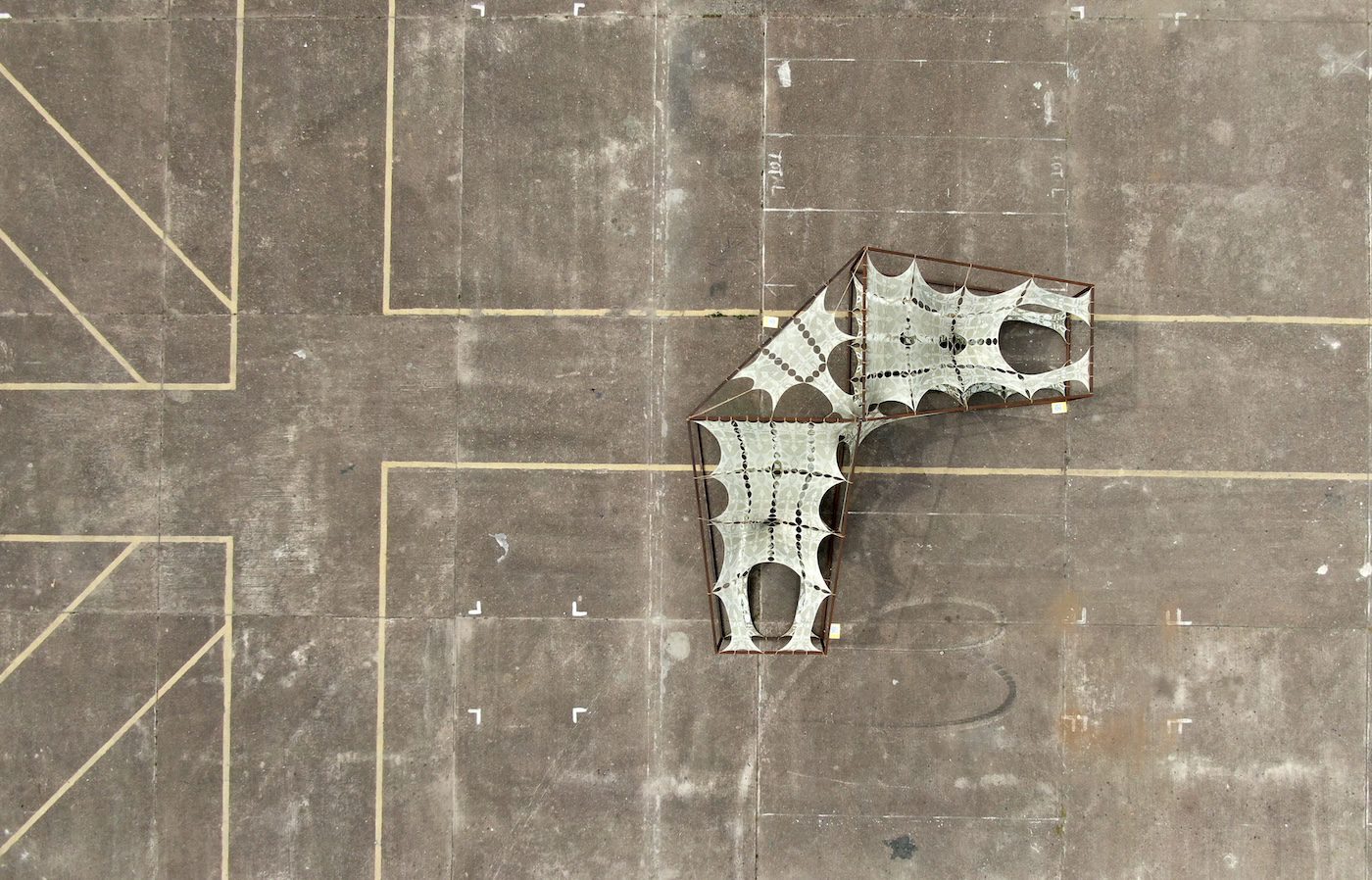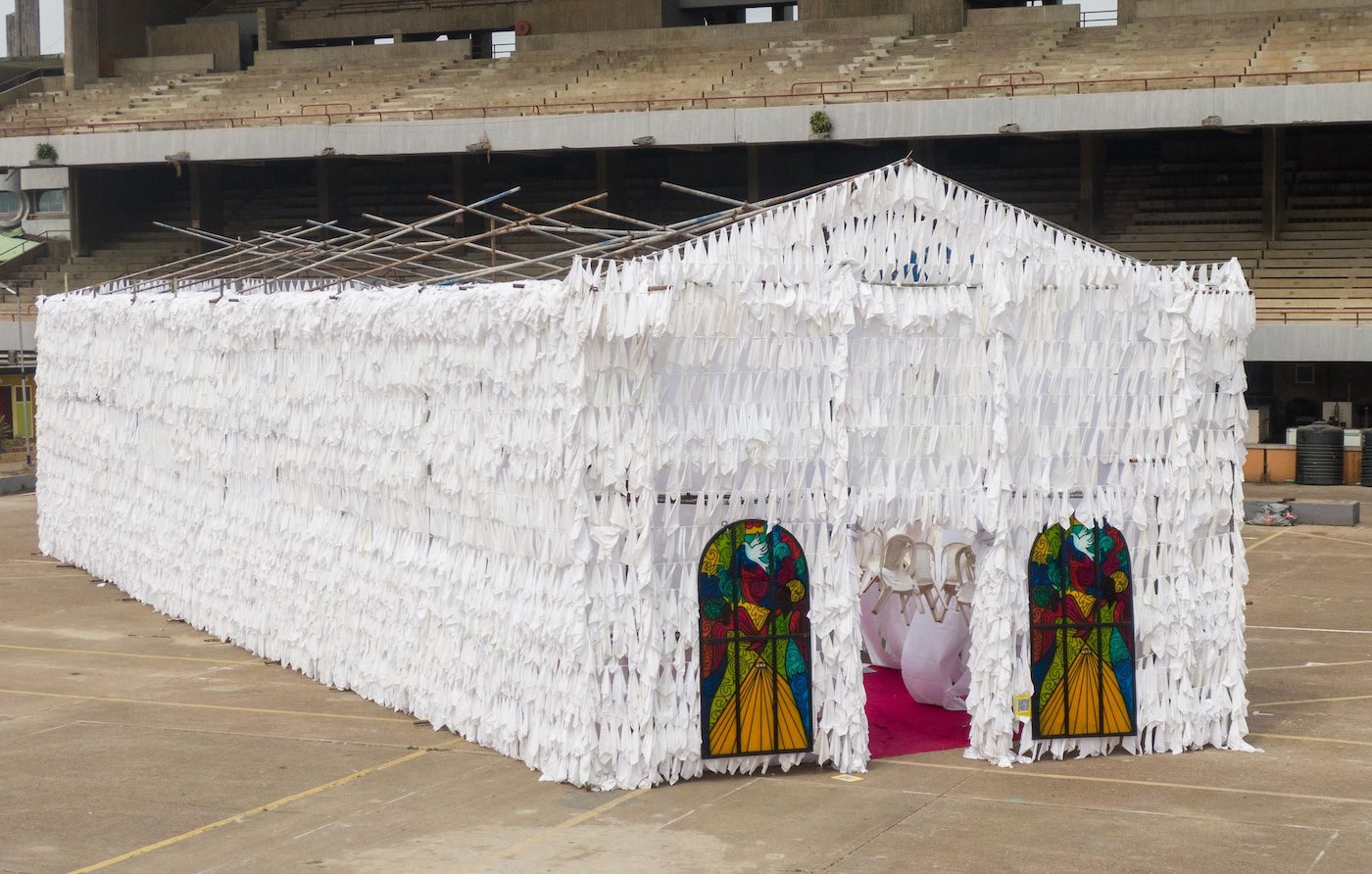Joseph Omoh Ndukwu examines the 4th edition of Nigeria's seminal biennial, which aimed to create a space to dream alternate paths in a systemic crisis.

Yussef Agbo-Ola "Eworo yi Ngbe" Lagos Biennial 3 - 10 February 2024, Courtesy of Lagos Biennial.
Tafawa Balewa Square (TBS), Lagos has always been surrounded by history. As a racecourse in colonial times, it saw horse races, polo games, parades, and cricket – pastimes enjoyed by the British and Nigerian elite. On its grounds, on October 1, 1960, Britain’s Princess Alexandra, representative of Queen Elizabeth II, lowered the British flag and raised the green and white of the newly independent nation. The square also served as an important venue during the 1977 Festival of Black Arts and Culture (FESTAC ’77). Until 1982, Nigeria’s heads of state gave their Independence Day speeches from its podium.
Even though the square has fallen from the prominence of its heyday, it remains haloed by the glory of its past and occupies an important place in the cultural memory of Lagosians, so much so that in 1997 it was chosen as the place for Afrobeat icon Fela Anikulapo Kuti to lie in state, an occasion flooded by thousands of admirers. And this month, in February 2024, it hosted the fourth edition of the Lagos Biennial.

Aerial view of the Shadow Pavilions. Lagos Biennial 3 – 10 February 2024, Courtesy of Lagos Biennial.
Themed REFUGE, the week-long biennial, in the words of its artistic directors Kathryn Weir and Folakunle Oshun, sought to address the nation-state and critically reflect on the site of the exhibition while exploring “how to create an operative notion of refuge that can offer alternate paths towards constructing renewable communities and work[ing] towards ecological justice in this historical moment of systemic crisis.” It aimed to serve as a source point from which to initiate an engagement with Lagos and Nigeria as historical and political entities – to re-examine the city as a space of world cultures and leverage that to speak to and offer a kind of shelter amid the issues of the twenty-first century. For a biennial that set out with this aim, it took a few noteworthy steps.

Victor Ehikhamenor, Miracle central (2024), Installation view, Lagos Biennial 3 – 10 February 2024, Courtesy of Lagos Biennial.
Victor Ehikhamenor’s Miracle Central, a temporary churchlike structure erected at one end of the square, was a remarkable embodiment and critique of Nigerian Pentecostalism. Outside, the building was bedecked with white handkerchiefs; inside, the walls were draped in large strips of white cloth and white plastic chairs hung from strings attached to rods across the open roof. Above a pulpit hung snare and bass drums, a cymbal, a talking drum, bells, an electronic keyboard, guitars, microphones, and microphone stands. Pre-recorded sounds played from the speakers, filling the air with church songs, prayers, and scraps of sermons. Ehikhamenor highlighted, in this installation, the powerful place religion and Christianity hold in Nigerian life. People come to these centers to obtain miracles, healing, and protection, for which they give everything they have. Miracle Central was set up to lay bare the exploitation and manipulation inherent in Nigerian religiosity, but its message applied just as strongly to the corrupt politics of the Nigerian state.

Victor Ehikhamenor, Miracle central (2024), Installation view, Lagos Biennial 3 – 10 February 2024, Courtesy of Lagos Biennial.
Traces of Ecstasy, a pavilion containing a performance and multimedia exhibition curated by KJ Abudu, worked its way across its themes through carefully considered selections. A breeze-block pavilion by Nolan Oswald Dennis employed a concentric circular design, situating itself within the idea of accommodating different identities and alternate realities, a house of rooms within rooms. Àdìrẹ tarps by Adeju Thompson hung above, providing shade. Out of dried gourd speakers put together by Evan Ifekoya came a motley of sounds—of water undergoing its state changes, Yorùbá drumming, Tafawa Balewa’s independence speech, meditative chimes, and the urban sounds of Lagos. The project offers an interwoven response to colonial legacies and suppressed indigenous wisdoms across Africa, examining the violence of the Nigerian state towards its masses and minorities, and providing, through the widening and associative mode of its composition, an avenue for free thought and resistance.

Traces of Ecstasy (2024), installation view, Lagos Biennial 3 – 10 February 2024, Courtesy of Lagos Biennial.
The need to speak up and the sheer restlessness of the soul in a stifling and brutal reality seemed to be behind several of the works in the Biennial. But some of them, it seemed, failed to reach anything higher than the mere act of speaking and doing simply because something had to be said and done. To go out of one’s way to respond artistically to a fraught era is to make work that stands not just as a censure and a cry, but as an emblem of an envisioned reality.

Bruce Onabrakpeya, Lagos Biennial 3 – 10 February 2024, Courtesy of Lagos Biennial.
Something about how some of the works were installed – or more appropriately, set down – took away from their resonance. Bruce Onobrakpeya’s sculptural pieces, for instance, which formed a part of the Gregarious Architectures section of the biennial, seemed lazily assembled and out of place. According to the biennial’s website, Gregarious Architectures was conceived to analyze “the utopian promises and dystopian experiences of modernity, with particular attention to Lagos and the nation state of Nigeria” as well as “to open spaces of transformation and imagine alternative economic, political, social, and spiritual forms.” Having this in mind, it was easy to make out the thinking behind selecting and installing Onobrakpeya’s works. The sculptures were some seven-foot-high assemblages of metal and plastic – car dashboards, engine parts, and odd bits of beads and bones welded and strung together. Thinking on the works themselves, one lit upon themes of recycling, alternate technologies, and creative hybridities. But hard as one looked, the works remained lost in context.

Ibrahim Mahama, « Yakachana » Installation View of Lagos Biennial 3 – 10 February 2024, Courtesy of Lagos Biennial.
The same could be said of Ibrahim Mahama’s piece Yakachana, a large spread of black-brown jute sacks lying about the center of the square. While its conception was brilliant – a re-imagination of urban space through the discarded materials of toil, globalization, and exploitation – laid there the way it was, it seemed lame in effect. This is not a request for dramatic installation displays, but a disappointment at works seemingly displayed with no further thought beyond just having them in the biennial.
Speaking of how the installation of some of the works and possibly the selected works themselves fell short brings me to the assassination of General Murtala Muhammed* in 1976. Beside Tafawa Balewa Square, in the National Museum, is the car in which he was assassinated. Riddled with bullet holes, it echoes the country’s violent history. No work in the biennial, besides a few remarks during symposiums, spoke to that violent turning point in the character of Lagos and the history of Nigeria.

Em’kal Eyongakpa « Betok babhi, Babhi betandat, bassem 2022-2024 ». Lagos Biennial 3 – 10 February 2024, Courtesy of Lagos Biennial.
REFUGE featured several performances: from that of Raymond Pinto in Traces of Ecstasy to Em’kal Eyongakpa’s Betok babhi, Babhi betandat, bassem to the Albanian Conference’s Wahala, Freedom, Quantum Leap to Odun Orimolade’s colorful costumed dance of several participants. The idea for the biennial seemed to lean toward performance art, such that some of the architectural installations and sculptures looked like performances themselves. Unsuited to that mode, however, or insufficiently imagined in it, they appeared merely performative. Yussef Agbo-Ola’s Airi: The Stone Altar, which operated solidly within its mode as a sculptural installation, was an impressive work with its context right; it struck as a well-wrought construction for the contemplation of beauty and as an aesthetic inquiry into spatial mutability and depth – hence a gesture at new possibilities. Henrique Oliviera’s Island and Feda Wardak’s Hanging Imaginaries, though, seemed to yearn for more, or for less. They would have worked just fine had they been smaller sculptural pieces, but for works of their scale they needed a little more creative input to set them off. Some visual or sculptural hangings might have been helpful. But they sat like vessels waiting to be put to use.

The Albanian Conference in performance. Lagos Biennial, 2024. Photo by Joseph Omoh Ndukwu.
The Albanian Conference’s Wahala, Freedom, Quantum Leap, a wooden pavilion, video installation, and performance, was a work of protest. Its address was direct, impassioned, and riveting, the artists wearing white shirts printed with the words of their discontent: POLICE THE POLICE, END EUROPE, WE CAN’T LOOT AS MUCH AS YOU STEAL, FREE PALESTINE ABOLISH WHITE SUPREMACY. Although the performance sometimes seemed to lapse into bathos and excess, the work was a solid contribution: it endeavored to be capacious in its reach, and within the logic and limits of its vision, tried to offer a space for crying, for restructuring, and for dreaming. And that is what a refuge should be, a home that holds our crying but also nurtures our dreaming.
Joseph Omoh Ndukwu is a writer and editor living in Ibadan, Nigeria.
*Nigerian Head of State (1975-76)
ECOLOGIES
C&’s second book "All that it holds. Tout ce qu’elle renferme. Tudo o que ela abarca. Todo lo que ella alberga." is a curated selection of texts representing a plurality of voices on contemporary art from Africa and the global diaspora.
More Editorial